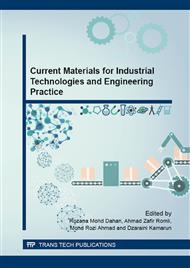[1]
S. Gan, T. Choo, and S. C. Lim, Timber Notes: Medium Hardwoods I Timber Technology Bulletin (Timber Technology Centre (TTC), FRIM, Kepong, 52109 Kuala Lumpur ISSN: 139−258 (1999) No. 11.
Google Scholar
[2]
Malaysian Timber Council (MTC), On Site Identification of Some Common Timber Used in Malaysian. Malaysian Timber Council, (2010). p.140.
Google Scholar
[3]
M. D. Strickler. Finger-jointed Dimension Lumber – Past, Present, and Future. Forest Products Journal 30(9): 51-56.
Google Scholar
[4]
T. H Yang, S. Y. Wang, C. J. Lin. M. J. Tsui and F. C. Lin. Effect of laminate configuration on the modulus of elasticity of glulam evaluated using a strain gauge method. J Wood Sci (2007) 53: 31–39. DOI 10. 1007/s10086-006-0818-z.
DOI: 10.1007/s10086-006-0818-z
Google Scholar
[5]
R.W. Jokerst. Finger Jointed Wood Product; United States Department of Agriculture, Forest Service. Research Paper FPL, (1981). p.24.
Google Scholar
[6]
G. Castro, F. Paganini, Parameters Affecting End Finger Joint Performance in Poplar Wood. International Conference of IUFRO S 5. 02 Timber Engineering, (1997).
Google Scholar
[7]
C. Bustos, R. Beauregard, M. Mohammad and R. E. Hernandez. Structural Performance of Finger-Jointed Black Spruce Lumber with Different Joint Configurations. Forest Product Journal, 53(9), 72-76, (2003).
Google Scholar
[8]
M. Mohammad. Finger-joint process and products quality. Value to Wood Project Report (FCC3). FP Innovations – For intec Division, St-Foy, Quebec, (2004).
Google Scholar
[9]
G. R Brock and Y.P. Chu. The strength of Finger Joint in Keruing. Malaysian Forester 36(1): 34-50, (1973).
Google Scholar
[10]
M. Ahmad and S. Muhammed. The performance of Meranti (Shorea spp. ) in structural Finger Joint. Bil 2 (1996) ISSN 0127-9092.
Google Scholar
[11]
M. Z. Sapari, J. Kasim, W. M. N. A. Rahman and A. H. Saleh. Bending Strength Properties of Finger Jointed Off-Cut Yellow Meranti (Shorea spp. ) Wood. J. Chem. Chem. Eng. 6 (2012) 997-1002.
Google Scholar
[12]
EN 385. Finger Joint Structural Timber: Performance Requirements and Minimum Production Requirements. European Committee for Standardization, B-1050 Brussels, (2001).
Google Scholar
[13]
BS 373. Methods of Testing Small Clear Specimens of Timber. British Standards Institution, (1957).
Google Scholar
[14]
BS 5291. Manufacture of finger joints of structural softwood. British Standards Institution, (1984).
Google Scholar
[15]
I. Barboutis, V. Vassiliou, S. Karastergiou. Effect o f Finger Length on Bending Strength Properties of Finger Jointed Steamed and Unsteamed Beech Wood, Proceedings of the second European Conference on Hardwood, (2005); pp.62-68.
DOI: 10.1002/app.25079
Google Scholar
[16]
BS 5268 ; Part 2. Structural Use of Timber. Code of Practice for Permissible Stress Design, Materials and Workmanship, (2002).
DOI: 10.3403/02523903
Google Scholar
[17]
M.Z. Sapari, J. Kasim, W. M. N. A. Rahman and A. H. Saleh, Bending Strength Properties of Finger Jointed Off-CutYellow Meranti (Shorea spp. ) Wood. J. Chem. Chem. Eng. 6 (2012) 997-1002.
Google Scholar


